From Vanuatu to Australia, and then Yishun: The yellow plant giving S’pore fall colours all year
Sign up now: Get ST's newsletters delivered to your inbox
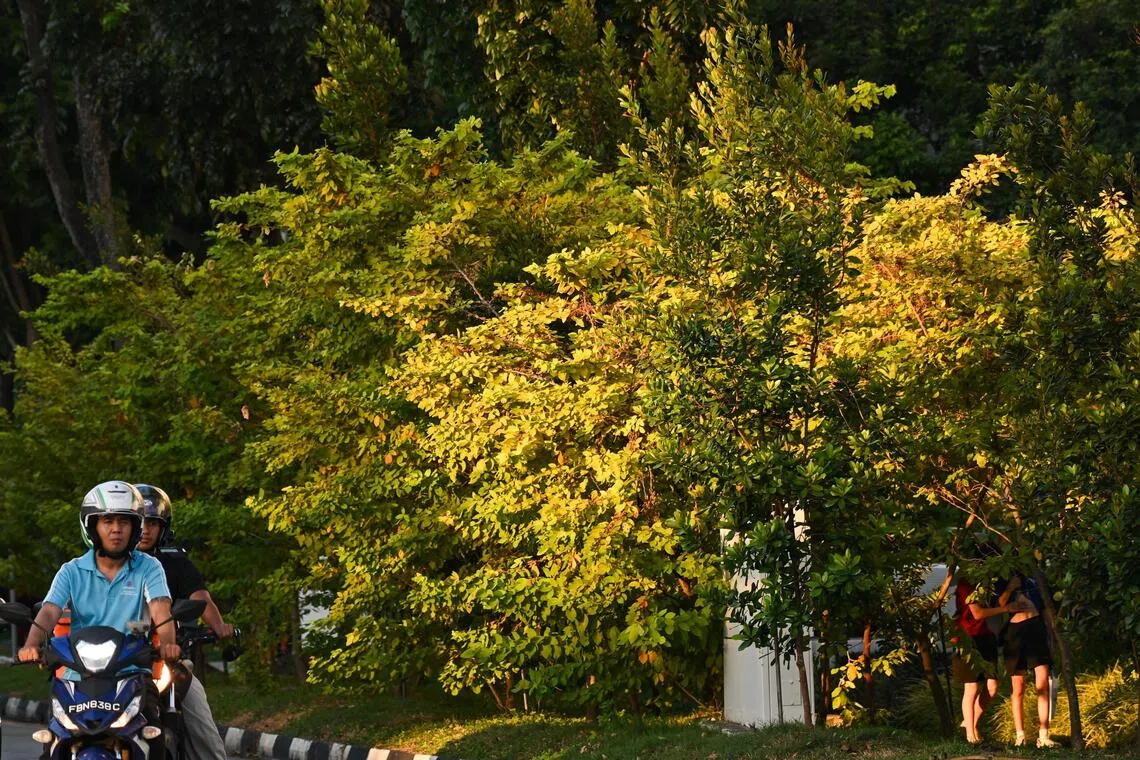
The yellow-leaved Dendrolobium umbellatum cv "Vanuatu" in front of Yishun Polyclinic in a photo taken on Oct 30.
ST PHOTO: SHINTARO TAY
Follow topic:
- Gardens by the Bay imported yellow Dendrolobium umbellatum cv 'Vanuatu' saplings to Singapore in 2010, intrigued by their potential for landscaping due to their unique foliage.
- The saplings successfully propagated from seed, maintaining their yellow colour, allowing for easy and cheap propagation. NParks now uses them in street planting.
- The plant is thriving in Singapore and is set to debut in Timor-Leste in 2025.
AI generated
SINGAPORE – As the weather cools in the Northern Hemisphere, fall foliage is sure to draw the eye. But even in tropical Singapore, the colours of autumn can be enjoyed year round – in Gardens by the Bay and along the country’s streetscapes, from Yishun to Bukit Panjang.
The bushy tree that bears these yellow leaves is known as Dendrolobium umbellatum cv “Vanuatu”. It is known to reach heights of 5m to 6m.
This is a cultivated variety (cv) of the Dendrolobium umbellatum, a tree species that has a wide native distribution, from East Africa to the South-west Pacific – including Singapore, where it can be found in areas such as Labrador Nature Reserve, Pulau Ubin and the Southern Islands.
It usually sports green leaves, but this cultivar was selectively propagated for its yellow leaves for their ornamental value.
The “Vanuatu” in its name is a reference to the Pacific Island nation where this variety is believed to have been first spotted.
The seeds of this yellow-leaved variant were recently gifted to Timor-Leste by Gardens by the Bay staff in August during a plant-sourcing trip there.
The seeds were propagated in a government nursery in September, and the cultivar is set to make its debut on the streets of Timor-Leste in end-2025.
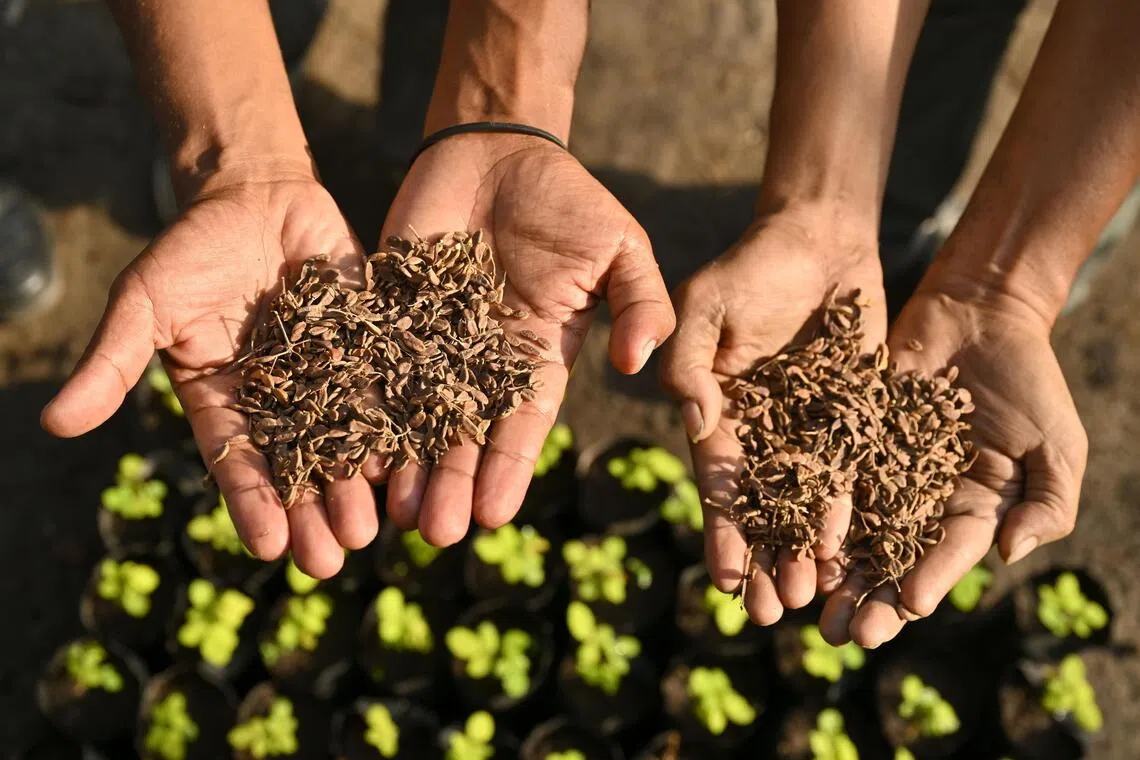
Dendrolobium umbellatum cv “Vanuatu” seeds that were given by Gardens by the Bay to Timor-Leste, along with seedlings of the plant (background), pictured in a government nursery.
ST PHOTO: DESMOND FOO
In October, Gardens by the Bay and the Timorese Ministry of Agriculture, Livestock, Fisheries and Forestry also inked a memorandum of understanding which covers plant exchange between the Singaporean institution and the ministry
The story of how this cultivar first took root in Singapore dates back 15 years, when Gardens by the Bay’s principal horticulturist, Mr Anton van der Schans, in 2010 decided to import 10 saplings from Australia to Singapore.
The saplings, bought from Darwin Plant Wholesalers, had piqued Mr van der Schans’ interest primarily because their yellow foliage would be good for landscaping the then nascent Gardens, which opened in 2012.
As Singapore does not have the seasonality that many flowering trees require to bloom, he said, plants with different types of foliage are one way to achieve visual variety in landscaped areas.
He was fairly confident that the saplings, which were yellow all year, would retain their colour when planted in Singapore, as Darwin has a similar climate to Singapore’s, albeit with higher temperatures and less rainfall.
“Any plant that has good foliage colour there should also retain that here,” he said.
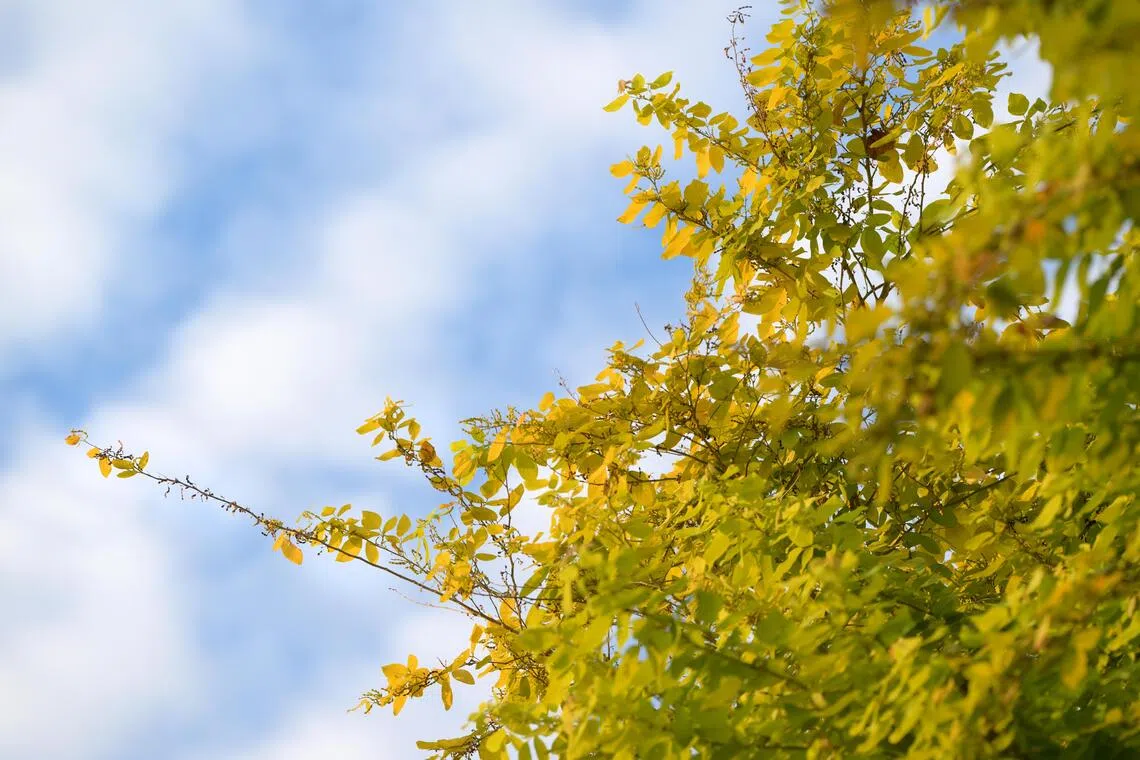
The yellow-leaved Dendrolobium umbellatum cv “Vanuatu” near a bus stop in Bukit Panjang photographed on Oct 28.
ST PHOTO: NG SOR LUAN
But another question remained: Would their offspring continue to inherit the same characteristics?
This depends on the type of genetic mutation that causes the plant’s leaves to be yellow.
In the plant world, there are two main types of mutations.
Germline mutations occur in the reproductive tissue of the plant, and can be passed on to its offspring. In comparison, somatic mutations happen in non-reproductive cells, such as in a leaf or flower, and will not be passed on.
Mr van der Schans said that while comprehensive studies on the cultivar have yet to be done, the mutation that gives the cultivar yellow leaves instead of green ones is likely a germline mutation. The mutation also possibly involves a dominant, rather than recessive, gene, he added.
Traits associated with a recessive gene are expressed only when both parents contribute the gene to the offspring, whereas traits associated with a dominant gene show up even when paired with a recessive copy.
Around early 2011, about 10 saplings of the plant – the first Dendrolobium umbellatum cv “Vanuatu” specimens in Singapore, to Mr van der Schans’ knowledge – were planted in Gardens by the Bay.
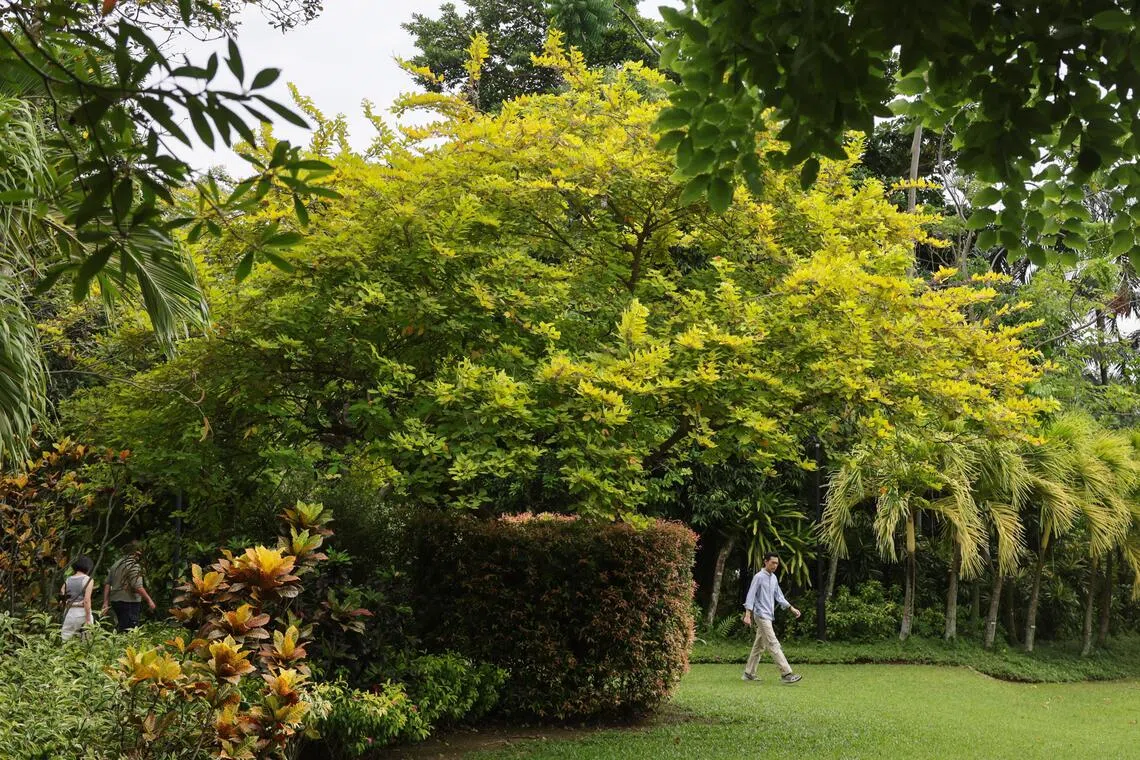
The last surviving of the 10 Dendrolobium umbellatum “Vanuatu” plants that Gardens by the Bay brought in from Darwin in the early 2010s pictured on Oct 29.
ST PHOTO: GIN TAY
It was about six to 12 months later that he noticed that their offspring – all bearing yellow leaves – sprouting beneath their canopies from seeds that the plants had dropped. Since then, the “grandchildren” of the original saplings have also had yellow leaves.
That successive generations of the plants have turned out yellow 100 per cent of the time came as a surprise to Mr van der Schans, largely because the odds of most mutations appearing between successive generations are low.
“That was when I knew it was worth propagating by seed. Otherwise, I’d assumed that yellow or variegated plants don’t come true from seed, and you usually have to grow them vegetatively by cuttings or even layering,” he said. Variegation in plants refers to irregular colours or streaks in foliage.
Plants grown by cuttings or layering are clones of their parents, whereas plants grown from seeds contain genetic material from two parents and may have traits that are harder to predict.
“But this one coming true to type from seed makes it extremely fast and cheap to propagate,” said Mr van der Schans, who gave seeds of the cultivar to National Parks Board (NParks) officers.
“True to type from seed” means that the seedling takes exactly after its parent – in this case, the yellow parent plants bear yellow offspring.
NParks has gone on to use the cultivar in streetscape planting.
In just over a decade since the first Dendrolobium umbellatum cv “Vanuatu” saplings were planted in Singapore in Gardens by the Bay, plants from the cultivar – many possibly the descendants of the original 10 saplings – can be found all over the country, giving streets a touch of fall foliage year round.

A row of Dendrolobium umbellatum cv “Vanuatu” trees in front of a public housing estate in Bukit Panjang.
ST PHOTO: NG SOR LUAN
NParks group director for streetscape Oh Cheow Sheng told The Straits Times that the Dendrolobium umbellatum cv “Vanuatu” thrives in coastal areas and has been planted on coastal roads such as Tanah Merah Coast Road.
It is also well-suited to urban areas that have growing conditions similar to coastal areas, said Mr Oh, citing conditions such as high light incidence, strong winds and dry environment.
Mr Oh said such urban areas include Dunearn and Napier roads, adding that the yellow foliage “adds a touch of colour and vibrancy to the landscape”.
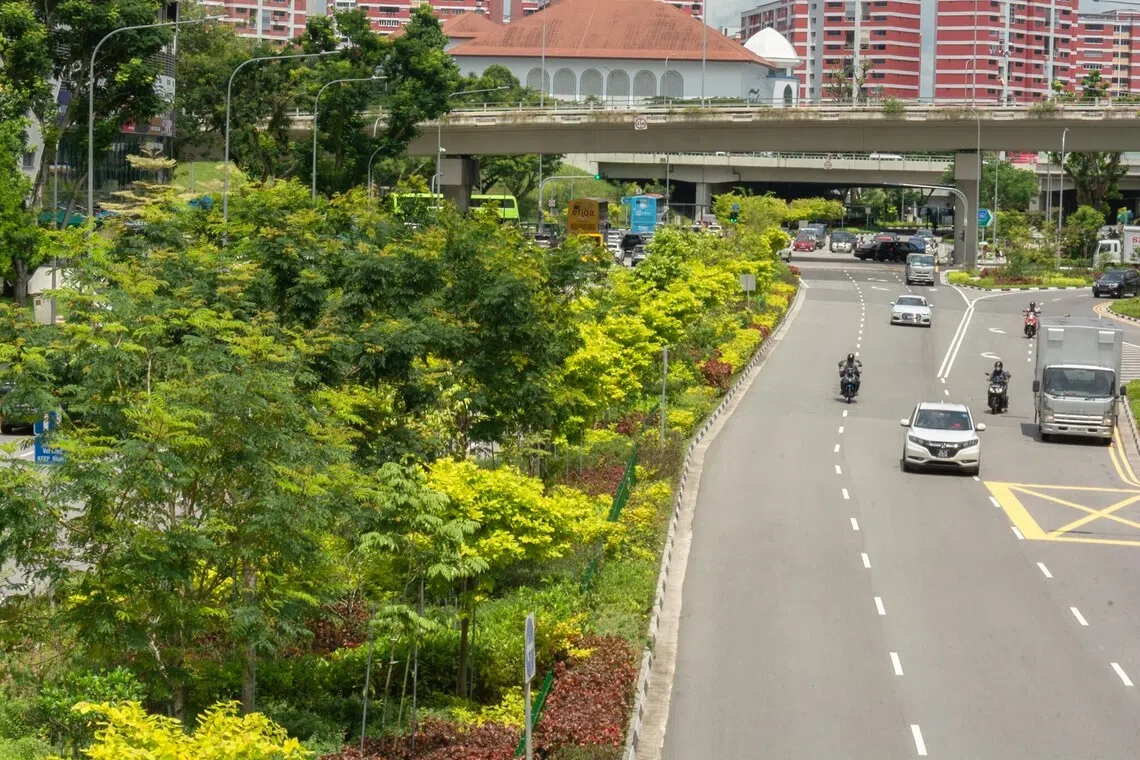
Dendrolobium umbellatum cv “Vanuatu” trees (centre) planted along Dunearn Road in Bukit Timah.
PHOTO: NATIONAL PARKS BOARD
Mr van der Schans said that while there also are yellow pigments in the green-leaved Dendrolobium umbellatum, these are typically masked by chlorophyll – the green pigment that plants use to make their own food through photosynthesis, a process that requires sunlight.
The genetic mutation in the Dendrolobium umbellatum cv “Vanuatu”, he said, causes less chlorophyll to be present in the leaves, and the yellow pigment to show through.
He noted that the plant shows its yellow colour most when exposed to sunlight regularly, and that portions of the plant that are often under shade could have greener leaves.
This is because more chlorophyll is present in these leaves to compensate for the lack of light exposure and produce sufficient food for the plant.
As far as Mr van der Schans knows, the Dendrolobium umbellatum cv “Vanuatu” was first brought into Australia from Vanuatu in the early 2000s by Australian landscape architect and horticulturist Arno King.
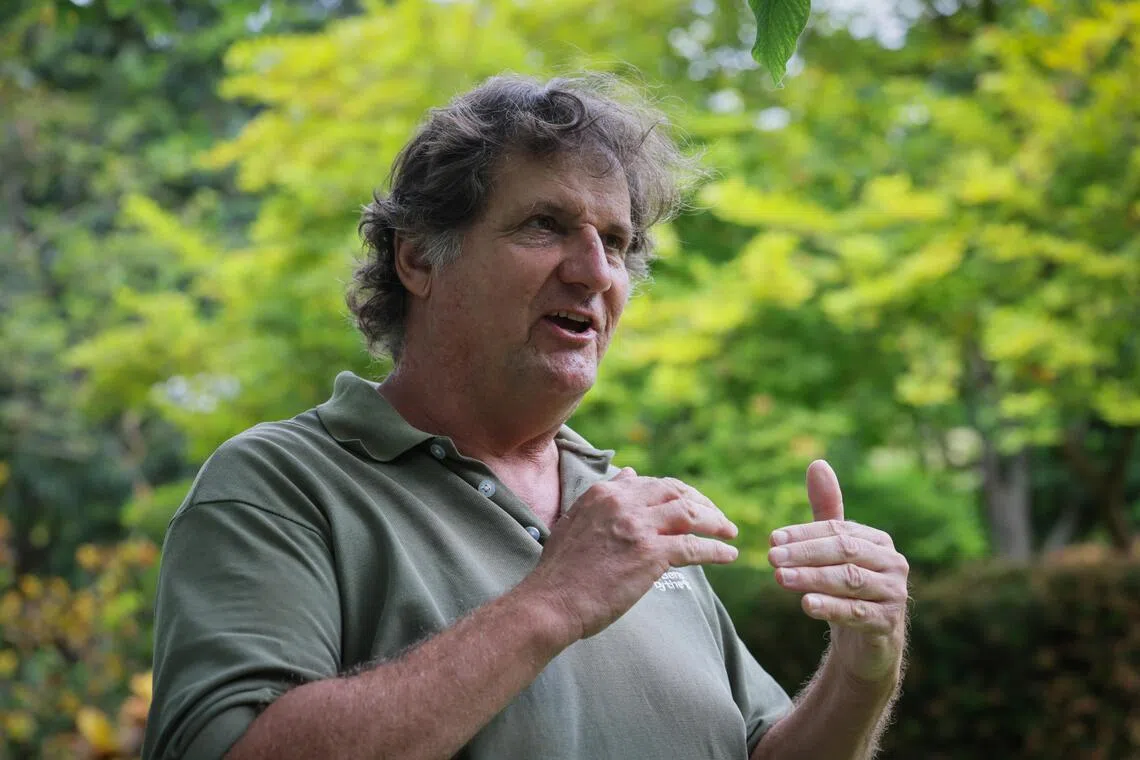
Gardens by the Bay principal horticulturist Anton van der Schans was part of a team that first brought the Dendrolobium umbellatum cv “Vanuatu” into Singapore in the early 2010s.
ST PHOTO: GIN TAY
Mr King had collected seed of the plant on Efate, the island on which Vanuatu’s capital, Port Vila, is located.
Mr van der Schans, who practised landscape architecture in Australia before moving to Singapore, said Mr King told him that locals in Vanuatu said the Dendrolobium umbellatum cv “Vanuatu” was brought to Efate around the 1990s from Tanna, another of Vanuatu’s islands.
The Gardens by the Bay principal horticulturist and Mr King believe that the variant could have first been spotted by English landscape gardener and botanist William Guilfoyle on Tanna in 1868.
Guilfoyle in an 1869 journal described a tree about 4.5m tall that was likely fully grown and had leaves that were “of so intense a golden yellow”.
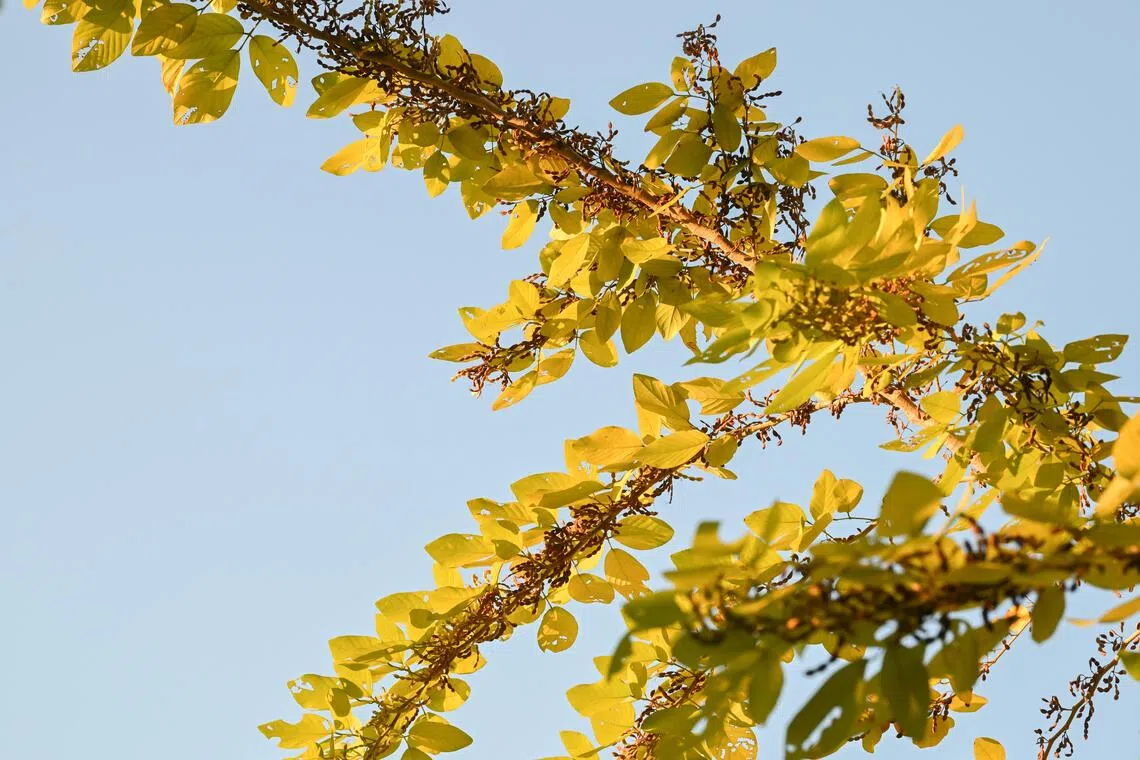
The golden yellow leaves of a Dendrolobium umbellatum cv “Vanuatu” plant outside Yishun Polyclinic.
ST PHOTO: SHINTARO TAY
He said that the tree had beauty and magnificence “unequalled in the flora of Polynesia, and perhaps not surpassed for elegance and splendour in any part of the world”, adding that he could not find seeds, seedlings or suckers from the tree and had to make do with cuttings, which died not long after he left Tanna.
Mr van der Schans notes that Guilfoyle had in the journal identified this tree as coming from the Inocarpus genus – something he believes was a mistake as trees from this genus can be up to 30m tall when fully grown, with much larger leaves, and also seed prolifically.
“So either Guilfoyle made a botanical boo-boo, and what he did see was actually the Dendrolobium, or somewhere on Tanna is possibly the world’s most beautiful tree, unseen by human beings,” said Mr van der Schans.


